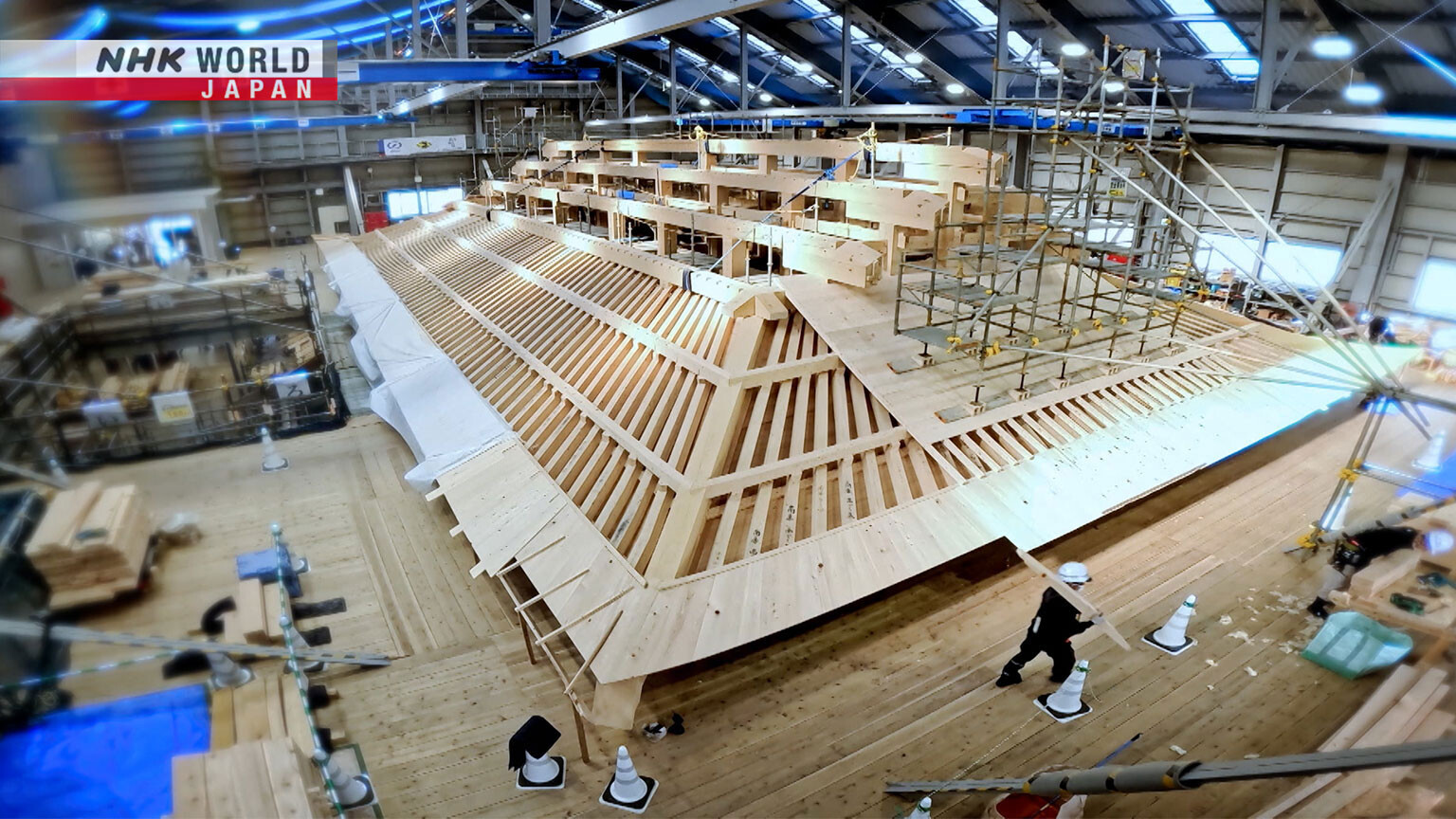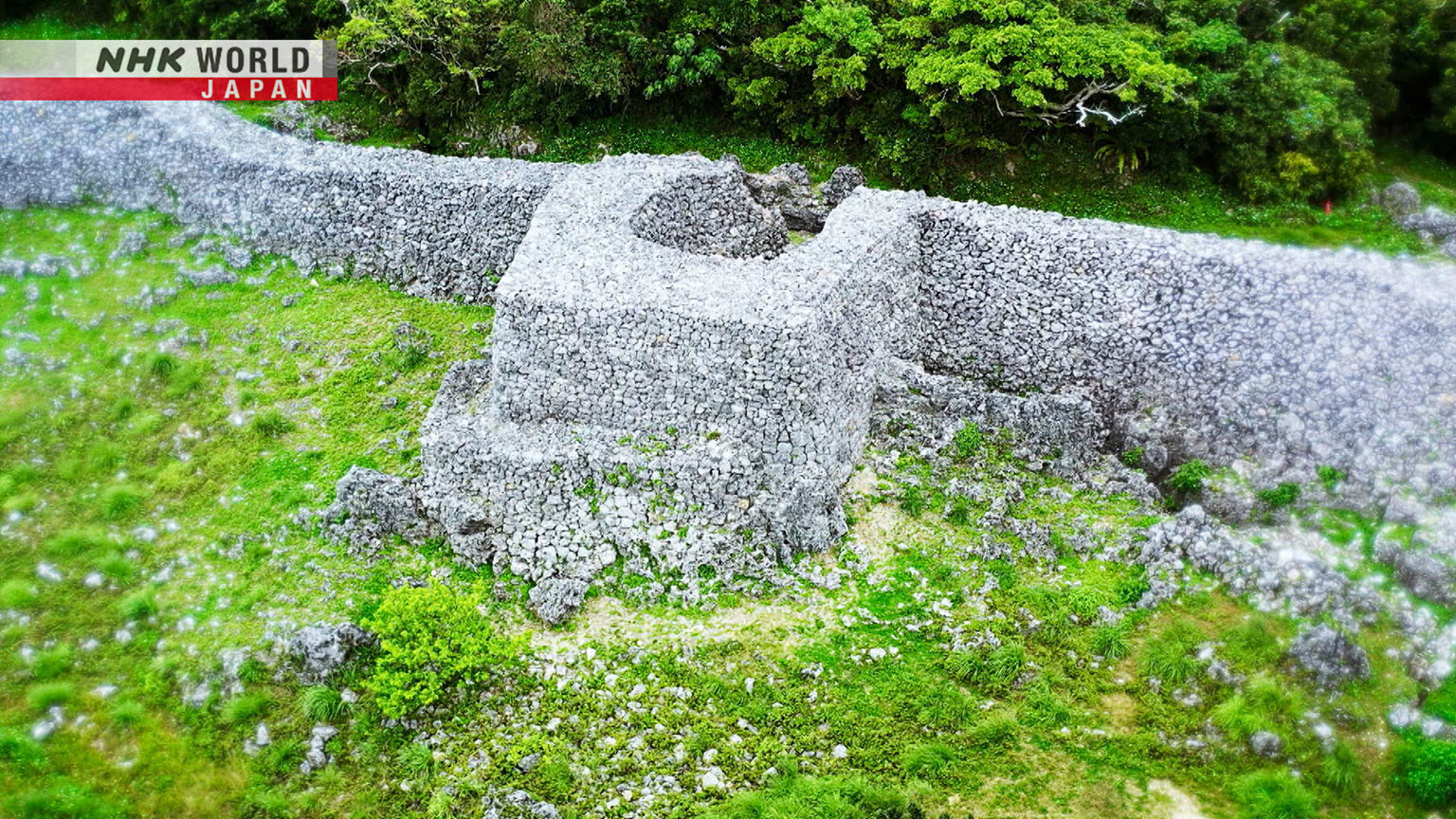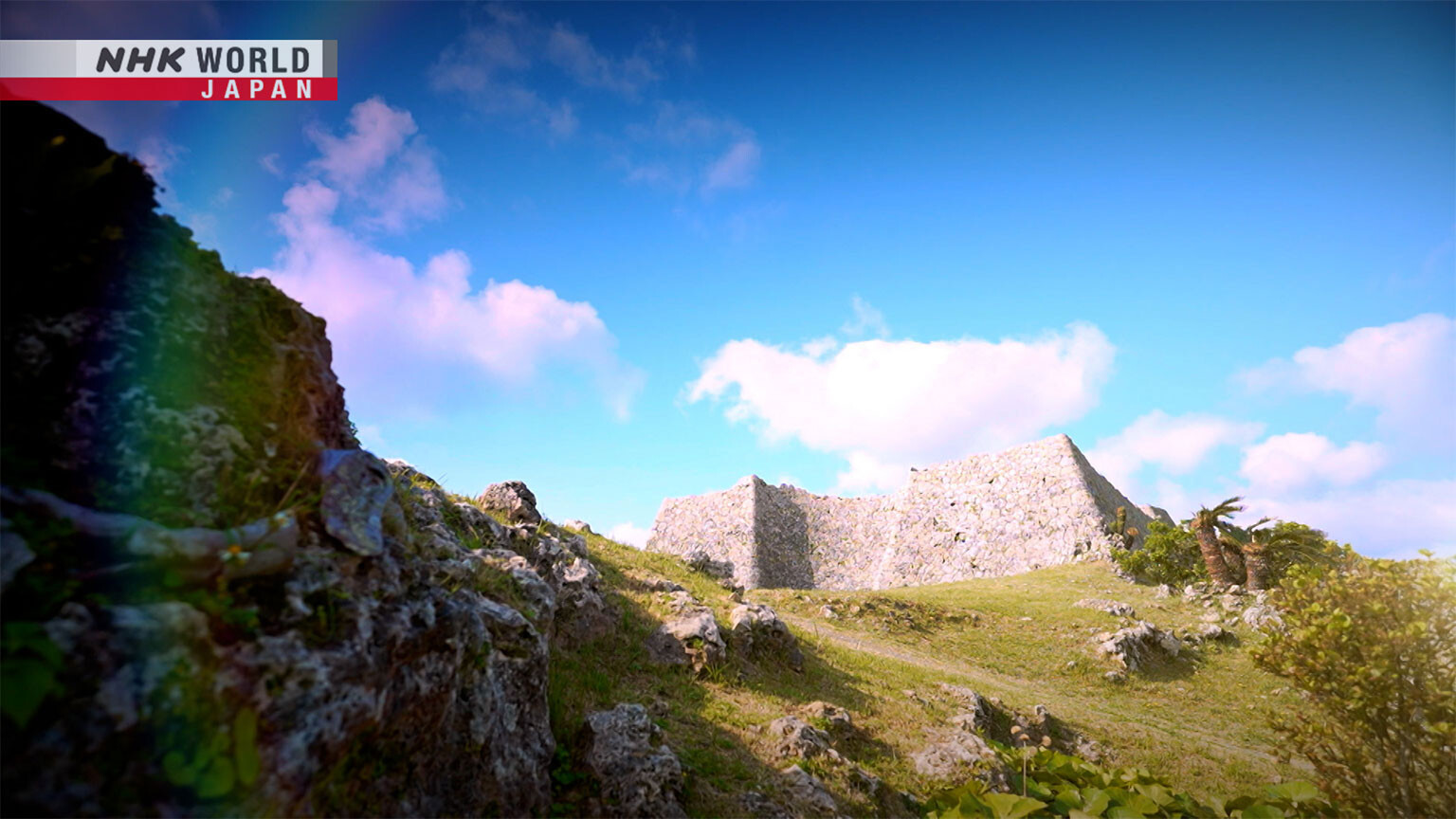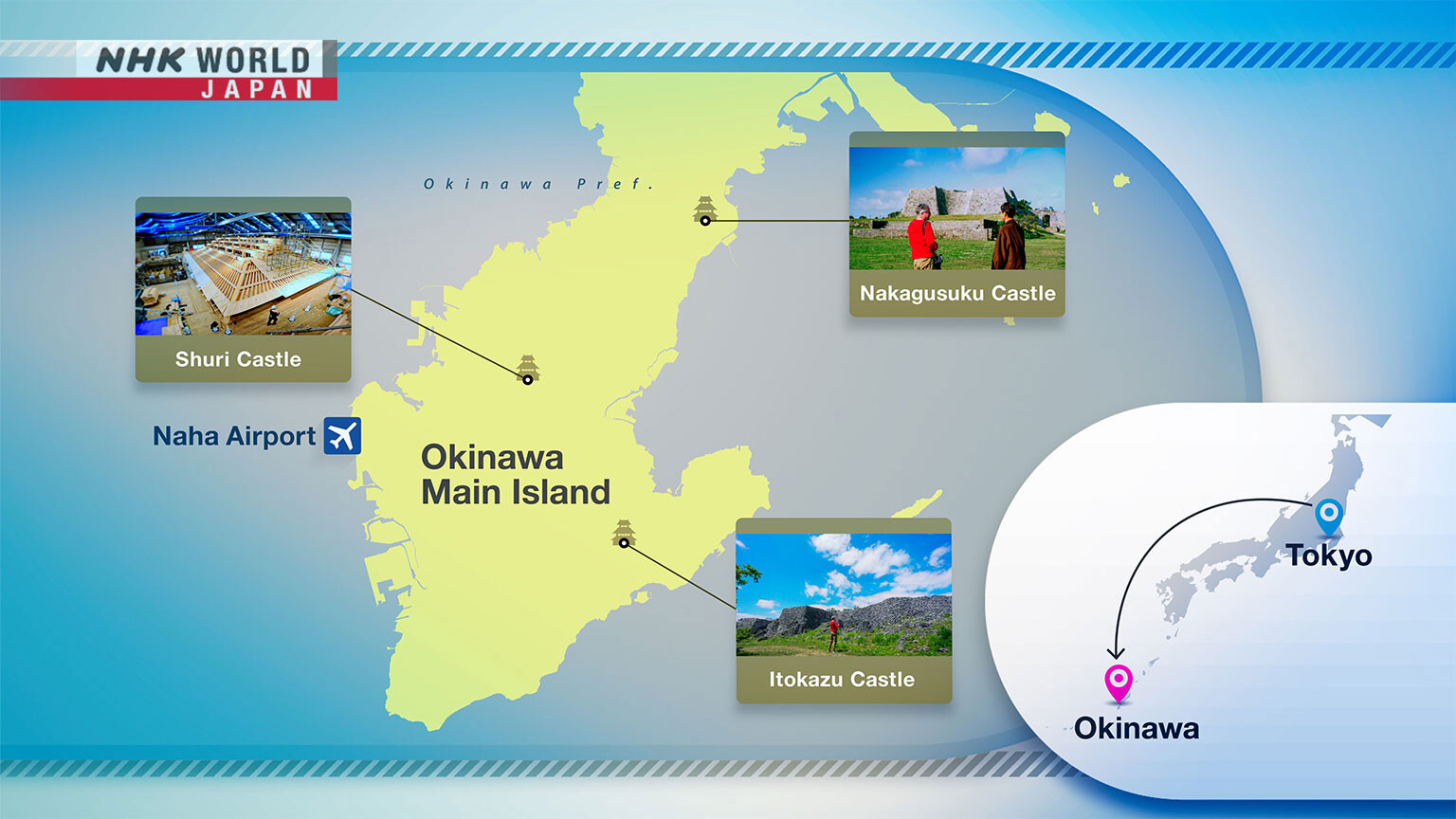Okinawa: Whispers of the Ryukyu Kingdom
Across the Ryukyu Islands, you can find elevated sites surrounded by stone walls. The walls protected gusuku or castles built between the 14th and the 15th centuries. Unlike the castles in mainland Japan that emerged in the Sengoku period (15th to 16th centuries), gusuku were also sacred places of community rituals and festivals. Photographer Alfie Goodrich feels the history of Okinawa through exploring these precious ruins.
Shuri Castle

Itokazu Gusuku Ruins

Nakagusuku Gusuku

Access

Transcript
"Journeys in Japan"
Fortresses far in the south....
reigning over the islands of Okinawa.
They symbolized power,
provided a place of worship...
and protected the people.
They are called "gusuku."
On "Journeys in Japan,"
we take in monuments that testify to a kingdom's rich heritage.
Okinawa
Whispers of the Ryukyu Kingdom
Okinawa is a world away from Tokyo,
some 1,500 kilometers to the south.
It consists of nearly 700 islands.
Photographer Alfie Goodrich
sets out to capture the island's mystery and glory.
Okinawa was once a kingdom called Ryukyu,
and it's said there was a unique castle here.
I wonder what it's like. Let's good to take a look.
Is this a castle in Okinawa?
Well, it looks just like a European castle.
It's amazing, isn't it?
This castle is called the Itokazu Gusuku.
In Okinawa, castles are called gusuku.
The ruins of this hilltop castle date to the early 14th century.
This rock is unusual.
It's called Ryukyu limestone.
A milky color and malleability are its characteristics.
The soft and porous limestone
formed from coral reefs was used in building materials.
The stonewall has a beautiful curve.
Such curves define gusuku.
This masonry style is unique to Okinawa.
It was considered cutting-edge in East Asia.
This fragment of a Chinese tea bowl from 600 years ago was excavated here.
The Ryukyu Kingdom traded with China at the time.
It imported pottery like this in large quantities.
From the late 14th century to the early 16th century,
the tea ceremony flourished.
So, the Ryukyu Kingdom began importing tea bowls
in large quantities from China to sell them to Japan at profit.
During excavations ruins have been found.
It is estimated that Itokazu had dozens of buildings.
It featured both a settlement and a fortress.
But there is no written record, so everything is a mystery.
Then we just have to use our imagination.
Is this a grave?
No, this is a place for prayer, called "utaki."
There are several sacred places like this here.
So, gusuku is a fortress,
and it's a settlement, and it's a place for prayer.
I wonder why that is?
Hello, nice to meet you.
Nice to meet you, too.
This is the Nakagusuku Castle.
Takebe Takuma is researching utaki in the old castle compounds.
Its stone walls were said to be the best-preserved of existing castles.
It's beautiful.
Nakagusuku Castle was built in the mid-to-late 14th century.
Is this a place of prayer?
Yes. There are several utaki here.
Each one offers different prayers.
This utaki is for rain.
That one prays for the island over there.
This is the central area.
This is the utaki.
In most cases, castles were built on hills or mountains.
Even if scaling and grading were done,
a rocky crop was always left at the top in its natural state.
And it was used as an utaki for prayer.
Do you feel gusuku are more like sacred sites than castles?
I believe that gusuku were originally places of prayer.
But ruling families called "Aji" moved in
and performed rituals to project themselves as gods.
By doing so, they displayed power to the people.
Aji attempted to govern the area by being seen as gods.
I think this beautiful place of prayer that the gusuku is
was all about creating a comfortable way
of governing the people of the area.
(Naha City)
I wonder if these are something to do with the praying?
Here they are.
Excuse me, what are these creatures?
These are "shisa." They are guardians of Okinawans.
We put them on rooftops and gates. They are popular here.
What is this district famous for?
Our pottery. It's called Tsuboya-yaki.
We have made tableware and shisa here from long ago.
I specialize in shisa.
Shimabukuro Jouei has been crafting the lion figures since childhood.
In recognition of his mastery,
the government named him as a distinguished traditional craftsperson.
This is the stokehole of the "noborigama" kiln.
It is the first place where the fire is lit.
A noborigama is an ascending kiln.
In its heyday, the district had dozens of them.
Why was this style adopted here?
Around 1682, Ryukyu Kingdom officials ordered three kilns
to be consolidated here,
probably for efficiency.
Shuri Castle of the Ryukyu Kingdom is located on that hill.
Look at this 2,000 yen banknote. It features the Shurei-mon gate.
That's it over there.
Shurei-mon gate is at the very entrance of Shuri Castle.
When was Shuri Castle built?
It was likely built in the second half of the 14th century.
Located on a hill overlooking the city of Naha,
the castle thrived as the heart of the Ryukyu Kingdom.
(Kankai-mon gate)
The curve is gorgeous.
Yes, indeed.
I think the difference between the walls of Ryukyu gusuku
and pre-Edo and Edo castles is defined by the gentle curves.
I think this reflects the Ryukyu aesthetic.
I can hear water.
It's spring water. Shall we go see it?
The water, called "ryuhi," is considered Okinawa's finest.
It was served every day to the king
and to guests from China called "Sapposhi."
Sapposhi were envoys sent by the Chinese emperor.
This scene depicts Sapposhi on route to deliver China's approval
of the new Ryukyu king's coronation.
Beyond the gate is the "Seiden,"
the main palace where the kings once lived.
- After you.
- Thank you.
Is this the Seiden?
The Seiden is under restoration.
In 2019, a devastating fire razed six castle buildings,
including the Seiden.
But the castle is being reconstructed to its former glory.
Please come in.
Kawakami Hiroyuki is directing the restoration.
What is this?
This place is called the "gensun-jo."
We check all our intricate designs using real-scale drawings.
Veteran carpenters specializing in temple and shrine architecture
have assembled here from all over Japan.
There's also a novice.
I was just a high school student three years ago,
but now I am working to rebuild Shuri Castle as a resident of Okinawa.
It was really a surprise. And I am proud about the work I get to do.
The main material is "hinoki" cypress.
Of the 10,000 timbers being used, more than 6,000 are hinoki.
So
it looks like you have a little space here
where the public can come and see everything that's happening.
Yes. We received significant donations worldwide
for Shuri Castle's reconstruction.
So, we want to transparently show people
the progression of work at the reconstruction site.
And now is the time to see it in progress.
So, we hope people will enjoy this.
Shuri-jo Castle is the largest gusuku in Okinawa.
It's also a symbol to the Okinawan people.
And it getting back its appearance is like them regaining their identity.
And I look forward to that happening in 2026.
(Shuri-kinjo town)
Hello.
This cobblestone is very beautiful.
It's the Shuri-kinjo town path.
It was constructed around 1522 to connect Shuri Castle and Naha's port.
The path was also used for defense.
Soldiers could easily access the port
to defend the castle against pirates.
How long is this path?
It used to be long, but now,
the existing section extends only 280 meters.
Yeah, I can feel the landscape of 500 years ago
just unfolding right before my eyes.
Another route stretches out from Shuri Castle.
It's the Futenma-kaido road.
(Toyama cobblestone)
The Ryukyu kings and their retinues
traveled along the Futenma Kaido.
And they would stop at the Futenmagu shrine.
Every year, they prayed here for good health.
There is a cave behind our main building.
People lived there long ago, and they made a place for prayer.
Then, they began to enshrine gods of a Ryukyu Shinto tradition.
A pine tree-studded road once connected
the Futenmagu shrine to Shuri Castle,
but...
In 1945, the Battle of Okinawa broke out,
and the shrine was destroyed.
A bullet hole in the gate serves as a reminder.
The Futenma-kaido, where kings once passed,
is now buried under the runways of a US base.
We plan to plant pine trees along the former Futenma road
if the US Futenma Air Base is returned to Japan.
In the meantime, we are now constructing a park in front of the shrine.
Will the beautiful pine canopy be resurrected one day?
The Sakaemachi Ichiba is a maze-like market crammed with 120 stalls.
Excuse me, what is this vegetable?
This is "goya" bitter gourd, an Okinawan summer vegetable.
May I photograph them?
Sure, just make them look good.
Oh. Man, this looks good.
Do people here like pork?
Yes, very much so.
Nothing goes to waste.
People even like tails, which make broth more flavorful.
By day, the Sakaemachi Ichiba is busy with shoppers.
And by night...
it turns into a pub paradise.
Here you are, "goya champuru" and "mozuku" tempura.
Looks great.
Enjoy.
(Mozuku tempura)
Oh, wow. Wow. Mozuku is a kind of seaweed,
but it's mixed in here with carrots and onion.
And there's also like a taste of tuna as well.
Very, very good.
A stir-fry of goya, egg and tofu.
That's goya champuru, an Okinawan signature dish.
This mixture of flavors here with the egg
and the slightly bitter goya is very, very delicious.
What a beautiful sound.
What is your instrument?
The "sanshin," a traditional Okinawan instrument.
Irei Shunichi is a singer-songwriter.
Alfie, you are touring Okinawa's gusuku, aren't you?
Actually, there is a ruin in my hometown.
It's a little far, but would you like to go?
Yes, I would love to.
OK, let's go.
About an hour by ferry from the main island...
That's Izena Island with its human form.
It looks just like a person sleeping.
- Well, what a beautiful day.
- Yes, yes.
It's an amazing day.
Scenic Izena is easy to explore.
It is small, with a circumference of about 16 kilometers.
Izena gusuku was on this mountain.
A bit of the stone wall is there.
Okay, this little piece of wall.
Ah, nice.
The fortress was built around the latter half of the 14th century.
The graves of the father of King Sho En
and other relatives are over here.
I admire Sho En.
This place is also related to my ancestors.
Over 500 years ago,
the king ensconced in Shuri Castle
was Sho En, who hailed from Izena.
Born into a family of farmers,
he left the island, and through sheer talent and dedication,
eventually became king of the Ryukyus.
A statue marks Sho En's birthplace.
He is the pride of Izena Island.
When I was a child, my grandfather showed me a simple family tree,
and I learned that I was a descendent of Sho En.
I was surprised and felt proud.
Did that inspire you?
Well, I always wanted to become a musician,
but that's not an easy career choice.
Yet, I was encouraged by Sho En to take a step forward.
I now live near Shuri Castle, where Sho En reigned.
When things are hard, I visit Shuri Castle to cheer me up.
Kagiyadefubushi
Classical Okinawan music played at celebratory events.
Gusuku is a castle, and I always thought that was something
that was more about battles or defenses.
But this trip has really changed that idea for me.
The mystery of gusuku is a history that still cannot be solved.
Gusuku as a place of prayer...
and the feelings of the people who still remain
towards their historical dynasty.
Gusuku is still such a profound and iconic symbol
for the Okinawan people,
and I've learned again on this trip
of the extremely diverse,
rich culture and history of Japan.
And I hope you'll join me again sometime soon.
From Tokyo to Okinawa,
it takes about three hours by air.